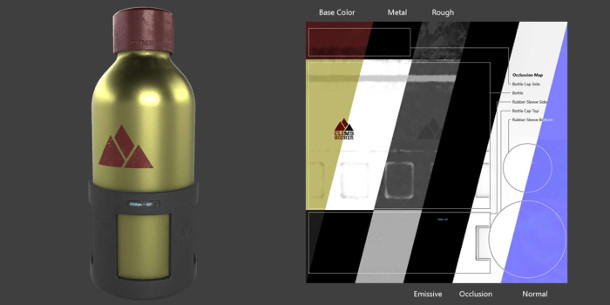Khronos Group adds PBR materials to glTF 2.0

Open standards consortium Khronos Group has released the specification for glTF 2.0, the latest version of its open format for real-time 3D assets, adding support for physically based rendering.
A PBR-ready open-standard for game assets and web applications
First announced in 2013, glTF is an “extensible, runtime-neutral format for real-time delivery of 3D assets”, intended for use in game engines and online 3D applications – and more recently, VR and AR.
While the original specification covered standard materials, since then, physically based workflows have become standard in the games industry, and are now supported in most game engines and art tools.
In addition, the old specification defined materials through GLSL shaders, which was fine for WebGL applications, but not those based around Microsoft’s Direct3D or Apple’s Metal APIs.
The glTF 2.0 spec addresses both issues, defining PBR materials “by a few concise parameters that can be used to generate shaders for any rendering API”.
In its news release, Khronos Group also says that it hopes future work will extend glTF’s capabilities further, “for example with advanced texture and geometry compression extensions”.
But will any games tools actually support it?
Of course, having an open format in which to exchange assets is only a benefit if there are actually applications between which to exchange them – and on that front, things have been quiet since 2013.
Otoy announced that it was looking into glTF as an alternative to FBX for the as-yet-unreleased OctaneRender 3.1, but as far as we’re aware, it’s the only developer in the DCC market to have done so.
While Khronos Group does note that engine developers have already started “transitioning to glTF 2.0”, most of the names it lists are web development or data visualisation tools like BabylonJS, three.js and Cesium.
The exception is online model-sharing website Sketchfab, which is widely used by entertainment artists as well as web devs.
There is also a list of companies from which glTF 2.0 is “seeing support” in a more general capacity, but while that includes Adobe, Marmoset, Nvidia and Oculus, it doesn’t include any game engine developers.
The news release does come with a quote from Tony Parisi, head of VR/AR strategy at Unity Technologies, but it seems to be in his capacity as co-editor of the glTF spec, and doesn’t mention Unity itself.
Availability
The glTF 2.0 specification can be found in Khronos Group’s GitHub repository, along with sample models and tools for converting files in OBJ, FBX and Collada format to glTF.
Read Khronos Group’s news release about the glTF 2.0 specification
